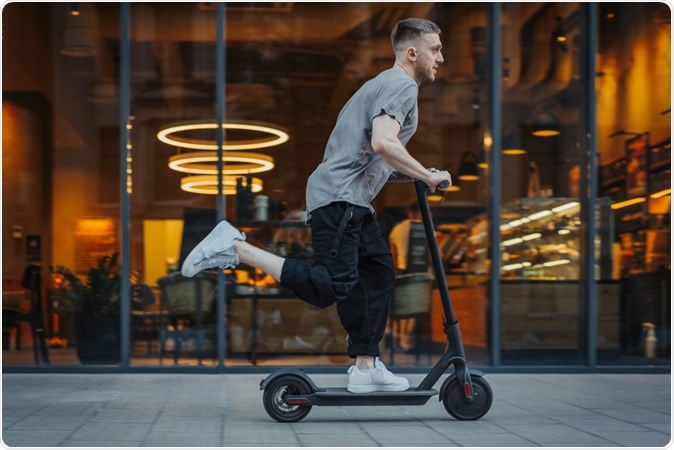A Rutgers study has found that riding electric scooters have led to three times higher facial and head injuries over the last decade.
The researchers write that over the last few years there has been a rise in the use of environmentally friendly vehicles that do not use gas. Each of the state has different helmet laws and many people are injured because they are not wearing protective gear. The study was published in the latest issue of the journal American Journal of Otolaryngology. The study is titled, “Craniofacial injuries related to motorized scooter use: A rising epidemic.”

Image Credit: Akaberka / Shutterstock
The team analyzed data from the Consumer Product Safety Commission's National Electronic Injury Surveillance system between 2008 and 2017. They looked at the frequency of facial and head injuries that come from use of these motorized scooters from 100 different participating hospitals. The team then extrapolated the injuries related to consumer products.
Over the last decade there have been 990 head or facial injuries resulting from electric scooter use. Across the nation there have been 32,000 estimated injuries. They noted that in 2008 there have been estimated 2,325 injuries and the numbers rose to 6,947 in 2017.
The age group of those injured were between 19 and 65 years. One in three those injured were between 6 and 12 years. Co-author Amishav Bresler, a resident at Rutgers New Jersey Medical School, “Children use motorized scooters marketed as toys, but in reality, certain models can reach speeds of almost 30 miles per hour.” Around 5 percent of the injuries were fractures especially in the skull and nose. Most of the injuries were closed head injuries including bleeding, bruising and concussion of the brain. Facial cuts and abrasions were also quite common.
The researchers analyzed helmet use among the victims. They noted that two thirds of the victims of the injuries were not wearing helmets. With age there was a rise in helmet use – 19 percent of the toddles used helmets while 67 percent of the senior riders used the helmet. Bresler said that different states have different helmet laws regarding motorized scooters. District of Columbia for example has classified these vehicles as “personal mobility devices” and thus do not have strict helmet laws. On the other hand in New Jersey electric scooters as traditional bicycles and thus mandate helmets in those under the age of 17 years.
Bresler said in a statement, “The United States should standardize electric scooter laws and license requirements should be considered to decrease the risky behaviors associated with motorized scooter use. In 2000, Italy implemented a law mandating helmet use for all types of recreational scooter drivers -- legislation that reduced head trauma in scooter riders from about 27 out of 10,000 people before the law passed to about 9 out of 10,000 people afterward.”
The authors conclude, “The incidence of motorized scooter related craniofacial trauma is rising, resulting in thousands of ED visits annually. Many patients are experiencing morbid traumatic injuries and may not be wearing appropriate protective equipment.” They call for more “public awareness and policy to improve safety and primarily prevent craniofacial trauma.”
Related study
A similar study was conducted by the Austin Public Health Department (APH), with assistance from the Centers for Disease Control and Prevention and others to look at the injuries associated with “rentable dockless electric scooters in Austin”.
For the study the researchers looked at e-scooter related injuries in Austin Texas between September 5, 2018 and November 30, 2018 from two sources –
- Austin-Travis County Emergency Medical Services (ATCEMS) incident reports
- Emergency Department (ED) syndromic surveillance chief complaint data from nine area hospitals
Results showed that during the study period there were 271 persons with potential e-scooters-related injuries of which 19 injuries were confirmed. The team noted that around half had fractures, lacerations and abrasions to the head, 70 percent had hand, arm or shoulder injuries, 55 percent had leg, knee, ankle and feet injuries and 18 percent had abdomen and chest injuries. One in three victims had a bone fracture of which 19 percent had injuries to more than one region in the body.
The study concluded that there should be a strong “injury surveillance related to emerging transportation vehicles. Questions will be asked about the risk of and types of injuries associated with the potential increased use of electric scooters, electric skateboards, unicycles, and Segway-type vehicles.” They also advocated public awareness and wrote, “Increase the frequency and methods of educational messages on safe e-scooter riding practices. These educational messages should emphasize both wearing a helmet and maintaining a safe speed while riding an e-scooter. Educational messages should especially target young adults 18 to 29 years of age.”
Sources:
- Craniofacial injuries related to motorized scooter use: A rising epidemic, Amishav Y. Bresler, Curtis Hanba, Peter Svider, Michael A. Carron, Wayne D. Hsueh, Boris Paskhover, American Journal of Otolaryngology, 2019, ISSN 0196-0709, https://doi.org/10.1016/j.amjoto.2019.05.023, https://www.sciencedirect.com/science/article/abs/pii/S0196070919304211?via%3Dihub
- https://www.austintexas.gov/sites/default/files/files/Health/Epidemiology/APH_Dockless_Electric_Scooter_Study_5-2-19.pdf